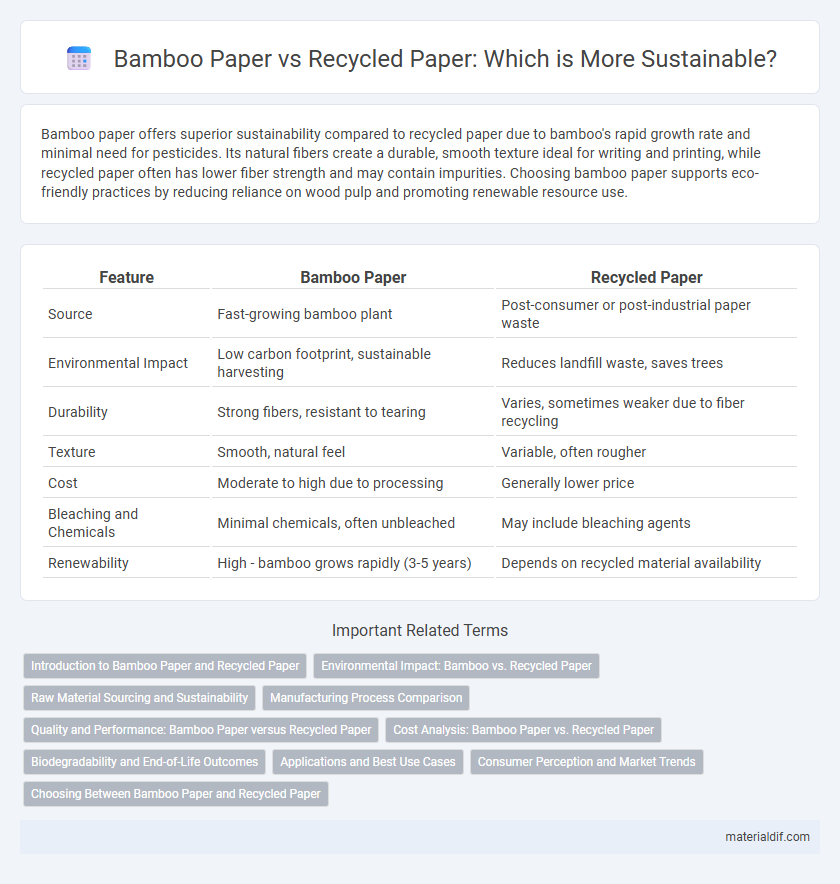Bamboo paper offers superior sustainability compared to recycled paper due to bamboo's rapid growth rate and minimal need for pesticides. Its natural fibers create a durable, smooth texture ideal for writing and printing, while recycled paper often has lower fiber strength and may contain impurities. Choosing bamboo paper supports eco-friendly practices by reducing reliance on wood pulp and promoting renewable resource use.
Table of Comparison
| Feature | Bamboo Paper | Recycled Paper |
|---|---|---|
| Source | Fast-growing bamboo plant | Post-consumer or post-industrial paper waste |
| Environmental Impact | Low carbon footprint, sustainable harvesting | Reduces landfill waste, saves trees |
| Durability | Strong fibers, resistant to tearing | Varies, sometimes weaker due to fiber recycling |
| Texture | Smooth, natural feel | Variable, often rougher |
| Cost | Moderate to high due to processing | Generally lower price |
| Bleaching and Chemicals | Minimal chemicals, often unbleached | May include bleaching agents |
| Renewability | High - bamboo grows rapidly (3-5 years) | Depends on recycled material availability |
Introduction to Bamboo Paper and Recycled Paper
Bamboo paper is crafted from fast-growing bamboo fibers, offering a sustainable alternative due to bamboo's rapid renewability and natural antibacterial properties. Recycled paper is produced by reprocessing used paper materials, reducing waste and conserving natural resources but often involves chemical treatments during manufacturing. Both types prioritize environmental benefits, with bamboo paper emphasizing raw material renewability and recycled paper focusing on waste reduction.
Environmental Impact: Bamboo vs. Recycled Paper
Bamboo paper offers a sustainable alternative to traditional recycled paper due to bamboo's rapid growth rate and lower resource demands, requiring less water and pesticides for cultivation. While recycled paper reduces waste by reusing fibers, it often relies on energy-intensive processes and chemical treatments that can produce pollutants. Bamboo paper's biodegradability and carbon sequestration potential contribute to a lower overall environmental impact compared to recycled paper, making it a more eco-friendly choice.
Raw Material Sourcing and Sustainability
Bamboo paper utilizes fast-growing bamboo, a highly renewable resource that requires minimal pesticides and water, making it more sustainable compared to recycled paper, which depends on post-consumer waste streams with variable quality. The raw material sourcing for bamboo paper supports forest conservation by reducing reliance on traditional wood fiber, while recycled paper production promotes waste reduction but may still involve chemical processing and energy consumption. Both materials contribute to sustainability, but bamboo paper offers a more consistent and eco-friendly raw material supply chain due to its regenerative cultivation.
Manufacturing Process Comparison
Bamboo paper manufacturing utilizes fast-growing bamboo fibers, which require less water and fewer chemicals compared to traditional wood pulp processes used in recycled paper production. The bamboo fiber extraction involves mechanical and chemical treatments that yield strong, durable sheets with a lower environmental footprint. Recycled paper manufacturing depends on post-consumer waste, often involving deinking and fiber reprocessing, which can reduce fiber quality and increase energy consumption.
Quality and Performance: Bamboo Paper versus Recycled Paper
Bamboo paper exhibits superior strength and durability compared to recycled paper due to its longer fibers, resulting in higher tear resistance and smoother texture for writing or printing. Recycled paper, often prone to lower quality, may contain shorter fibers and impurities, affecting its performance and brightness. Bamboo paper's natural antibacterial properties and fast-growing sustainability further enhance its eco-friendly appeal without compromising functionality.
Cost Analysis: Bamboo Paper vs. Recycled Paper
Bamboo paper generally costs more than recycled paper due to the cultivation and processing of fast-growing bamboo fibers, which offer superior durability and sustainability benefits. Recycled paper benefits from lower raw material costs but often requires additional processing to maintain quality, impacting overall price competitiveness. Businesses weighing cost versus environmental impact must consider long-term savings from bamboo paper's strength and renewability despite its higher upfront expense.
Biodegradability and End-of-Life Outcomes
Bamboo paper biodegrades faster than recycled paper due to its natural fiber composition and minimal chemical processing, resulting in reduced environmental impact. Recycled paper often contains synthetic additives or coatings that slow degradation and complicate composting or recycling efforts. Choosing bamboo paper enhances sustainable end-of-life outcomes by promoting quicker decomposition and nutrient return to ecosystems.
Applications and Best Use Cases
Bamboo paper excels in applications requiring durability and sustainability, such as premium stationery, eco-friendly packaging, and artistic paper products, due to its strong fibers and rapid renewability. Recycled paper suits mass-market printing, office documentation, and packaging where cost efficiency and resource conservation are priorities, leveraging post-consumer fiber content to reduce environmental impact. Selecting between bamboo paper and recycled paper depends on balancing performance needs with ecological considerations, making bamboo paper ideal for specialty uses and recycled paper preferable for everyday, high-volume tasks.
Consumer Perception and Market Trends
Bamboo paper is increasingly perceived as a sustainable and eco-friendly alternative to recycled paper, appealing to environmentally conscious consumers who prioritize renewable resources. Market trends indicate a growing demand for bamboo paper in sectors like packaging and stationery due to its softness, durability, and faster growth cycle compared to traditional wood pulp sources. Consumer preference is shifting towards bamboo paper as it is associated with lower environmental impact and ethical production practices, driving expansion in global green product markets.
Choosing Between Bamboo Paper and Recycled Paper
Choosing between bamboo paper and recycled paper depends on environmental impact and durability requirements. Bamboo paper offers rapid renewability, strong fibers, and minimal chemical use, making it a sustainable choice with excellent strength. Recycled paper reduces landfill waste and conserves natural resources but may have lower fiber quality and require more processing chemicals.
Bamboo Paper vs Recycled Paper Infographic

 materialdif.com
materialdif.com